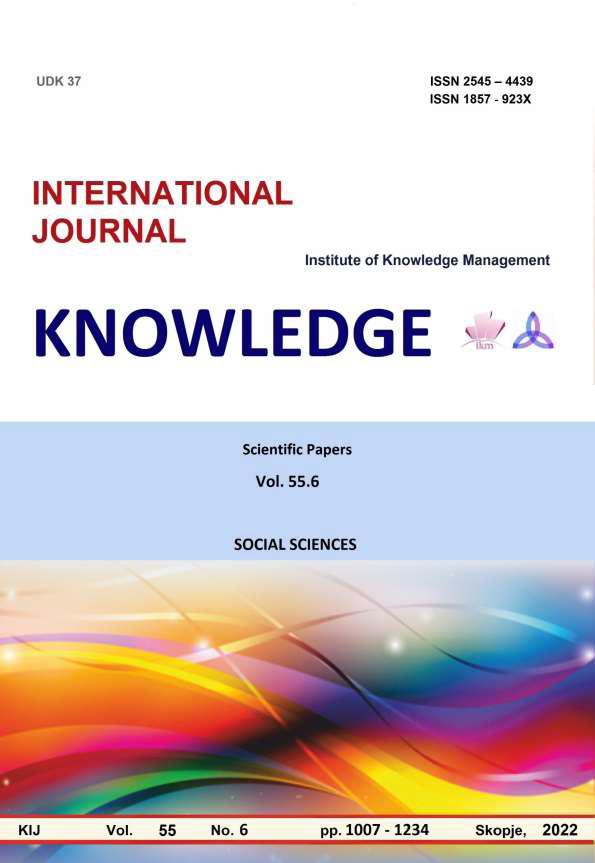THE ROLE OF ITIL IN APPLYING PROJECT MANAGEMENT FOR SMART CITIES SERVICE MANAGEMENT
Keywords:
Smart City, ITIL, ITSM, Project Management, Service Management, SCSMAbstract
This paper explores the role of the Information Technology Infrastructure Library (ITIL) framework in
project management procedures applied in smart city services. ITIL is a set of IT practices that focus on aligning IT
services with the needs of the required organization and specific applications, especially in business contexts.
Working on the ITIL and its flexibility, in this work a switch of the perspective from the business to the smart city
context is provided highlighting the limits and benefits of integrating project management and service management
through the ITIL framework in the smart city, going toward the Smart City Service Management (SCSM) approach.
ITIL and project management can smartly identify and satisfy city services needs by looking at the different
perspectives of multiple stakeholders, optimizing the system of problem detection, sharing the main reasonable
proposal and building appropriate project management paths to achieve the expected goals for stakeholders'
satisfaction following a value co-creation logic.
The paper is a conceptual contribution that adopts the 'advocating' perspective (MacInnis, 2011) to explain the
contribution of ITIL in supporting SCSM through project management
References
Albino, V., Berardi, U., & Dangelico, R. M. (2015). Smart cities: Definitions, dimensions, performance, and initiatives. Journal of urban technology, 22(1), 3-21.
AXELOS Limited. (2019). ITIL foundation: ITIL 4 edition.
Batty, M. (2014). Can it happen again? Planning support, Lee's Requiem and the rise of the smart cities movement. Environment and Planning B: Planning and Design, 41(3), 388-391.
Berger, D., Shashidhar, N., & Varol, C. (2020, June). Using ITIL 4 in Security Management. In 2020 8th International Symposium on Digital Forensics and Security (ISDFS) (pp. 1-6). IEEE.
By, R. T., & Burnes, B. (2013). Organizational change, leadership and ethics. London: Routledge.
Cannon D. Wheeldon D. & Stationery Office (Grande-Bretagne). (2011). Itil service strategy (2nd ed.). TSO.
Celino, I., & Kotoulas, S. (2013). Smart cities. IEEE internet computing, pp. 1-9.
Cervone, F. (2008). ITIL: a framework for managing digital library services. OCLC Systems & Services: International digital library perspectives.
Cobb, C. G. (2011). Making sense of agile project management: balancing control and agility. John Wiley & Sons.
Cook, D. J. (2010). Learning setting-generalized activity models for smart spaces. IEEE intelligent systems, 2010(99), 1.
Czarnecki, A., Klich, L., & Orłowski, C. (2013). Simulation of the IT Service and Project Management Environment. Biuletyn Wojskowej Akademii Technicznej, 62(1), 161-180.
Dominici, M., Zecca, G., Weis, F., & Banâtre, M. (2010). Physical Approach in Smart Homes. In Smart Spaces and Next Generation Wired/Wireless Networking (pp. 111-122). Springer, Berlin, Heidelberg.
Eskerod, P., & Huemann, M. (2013). Sustainable development and project stakeholder management: What standards say. International Journal of Managing Projects in Business.
European Commission Smart Cities (2018). Available from: https://ec.europa.eu/info/eu-regional-and-urban-development/topics/cities-and-urban-development/city-initiatives/smart-cities_en.
Fernández-Carreiras, D., Cuni, G., Klora, J., Martin, M., Matilla, O., Nardella, A., & Pérez, A. (2013). Using Prince2 and ITIL practices for computing project and service management in a scientific installation. Proc. ICALEPCS2013, San Francisco, Calif., USA, 6-11.
Frost & Sullivan smart city service. https://ww2.frost.com/wp-content/uploads/2019/01/SmartCities.pdf
Gallacher, L., & Morris, H. (2012). ITIL foundation exam study guide. John Wiley & Sons.
Giffinger, R., & Gudrun, H. (2010). Smart cities ranking: an effective instrument for the positioning of the cities?. ACE: architecture, city and environment, 4(12), 7-26.
Hinde D. (2012). Prince2 study guide. Sybex Imprint John Wiley & Sons Incorporated. Retrieved September 26 2022 from http://proquest.safaribooksonline.com/9781119970781.
Jayasena, N. S., Mallawaarachchi, H., & Waidyasekara, K. G. A. S. (2019). Stakeholder analysis for smart city development project: an extensive literature review. In MATEC web of conferences (Vol. 266, p. 06012). EDP Sciences.
Khazanchi, D., & Petter, S. (2006). The need for improved IT project management in e-service projects and beyond. E-Service Journal, 5(1), 1-3.
Lee, J., & Lee, H. (2014). Developing and validating a citizen-centric typology for smart city services. Government Information Quarterly, 31, S93-S105.
Lee-Kelley, L., & Kin Leong, L. (2003). Turner's five-functions of project-based management and situational leadership in IT services projects. International journal of project management, 21(8), 583-591.
Ma, M., Preum, S. M., Tarneberg, W., Ahmed, M., Ruiters, M., & Stankovic, J. (2016, May). Detection of runtime conflicts among services in smart cities. In 2016 IEEE International Conference on Smart Computing (SMARTCOMP) (pp. 1-10). IEEE.
Maclnnis, D. J. (2011). A Framework for Conceptual Contributions in Marketing. Journal of Marketing, 75(4), 136–154. http://www.jstor.org/stable/41228616.
Marrone, M., & Hammerle, M. (2018). Smart cities: A review and analysis of stakeholders’ literature. Business & Information Systems Engineering, 60(3), 197-213.
Marrone, M., & Hammerle, M. (2018). Smart cities: A review and analysis of stakeholders’ literature. Business & Information Systems Engineering, 60(3), 197-213.
McGlynn, D. (editor), (2018). European Commission, Directorate-General for Agriculture and Rural Development, The European Agricultural Fund for Rural Development: digital and social innovation in rural services: projects brochure, Publications Office, https://data.europa.eu/doi/10.2762/814170.
Olander, S. (2007). Stakeholder impact analysis in construction project management. Construction management and economics, 25(3), 277-287.
Pons, D. (2008). Project management for new product development. Project management journal, 39(2), 82-97.
Pries, K. H., & Quigley, J. M. (2010). Scrum project management. CRC press.
Raydugin, Y. (2013). Project Risk Management: Essential Methods for Project Teams and Decision Makers. John Wiley & Sons.
Rouse, Margaret; Bigelow, Stephen J. (2015). ITSM (IT Service Management). https://www.techtarget.com/searchitoperations/definition/ITSM
Stackpole, C. S. (2013). A User's Manual to the PMBOK Guide. John Wiley & Sons.
Steinberg, L. A. (2011). ITIL Service Operation (Best Management Practices). The Stationery Office.
Stoshikj, M., Kryvinska, N., & Strauss, C. (2013, December). Project management as a service. In Proceedings of International Conference on Information Integration and Web-based Applications & Services (pp. 220-228).
Thejendra, B. S. (2014). Practical IT Service Management: A concise guide for busy executives. IT Governance Publishing.
UNITED NATIONS, DEPARTMENT OF ECONOMIC AND SOCIAL AFFAIRS, POPULATION DIVISION (2019). World Urbanization Prospects: The 2018 Revision. New York: United Nations.
Walletzky, L., Buhnova, B., & Carrubbo, L. (2018). Value-driven conceptualization of services in the smart city: a layered approach. In Social dynamics in a systems perspective (pp. 85-98). Springer, Cham.





